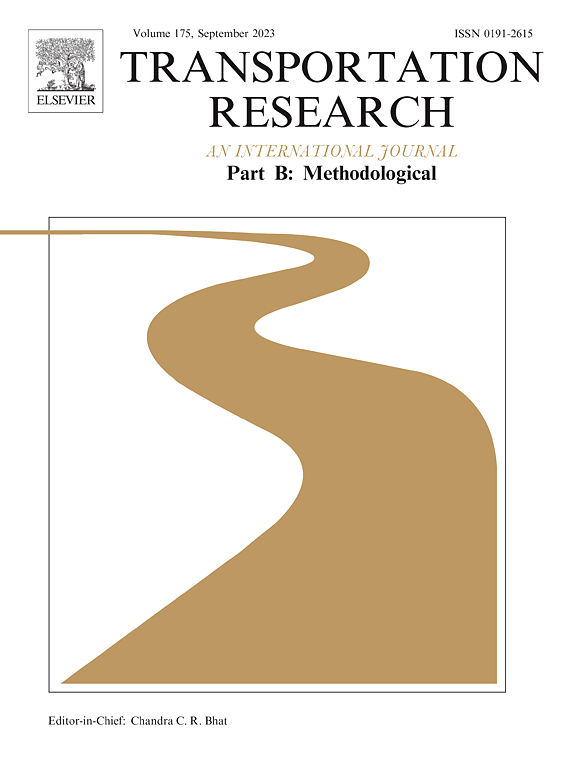出行激励:将绿色服务和碳排放纳入网约车市场
IF 6.3
1区 工程技术
Q1 ECONOMICS
引用次数: 0
摘要
增加个人在减排方面的责任是解决交通可持续性问题的潜在有效途径。近年来,碳包容计划被广泛实施,以激励个人的低碳出行行为。在实践的激励下,本文考察了绿色服务与碳包容计划相结合的网约车市场,了解政府主导的碳包容计划如何影响网约车市场的运行,以及减少碳排放和促进电气化的前景。我们为网约车平台提出了两种产品策略:(a)电动车和燃油车混合服务的单一产品策略;(b)电动汽车提供绿色服务和汽车提供基础服务的差异化产品战略。在讨论碳纳入对网约车市场的影响时,我们也考虑了不同国家/地区采用电动公交车的显著差异。我们的研究结果表明,如果没有政府主导的碳包容,网约车平台更适合采用单一产品策略。在政府主导的碳包容下,当外部公共交通的电气化率不是很高,而碳激励足够高时,平台可以通过采取差异化产品策略来提高其利润。考虑到平台的利润最大化决策,我们的分析还强调,当外部选项的电气化率较低而碳激励较高时,碳包容方案对网约车市场的影响在各个方面都更好,这是网约车平台、司机和政府都希望看到的双赢结果(如果政府希望看到更好的司机福利的话)。网约车市场的电气化和碳减排)。此外,增加网约车市场的潜在电动汽车数量和司机总数对平台(获得更高的利润)和政府(可能关心增加司机福利、电气化率和网约车市场的总碳减排)都是有意义的。获得的管理见解为平台运营差异化服务和政府实施碳包容计划提供决策支持。本文章由计算机程序翻译,如有差异,请以英文原文为准。
Toward mobility incentive: Integrating green service and carbon inclusion scheme into the ride-hailing market
Increasing individual responsibility for reducing emissions is a potentially effective way to address mobility sustainability issues. In recent years, the carbon inclusion scheme has been widely implemented to incentivize individual low-carbon travel behaviors. Motivated by the practice, this paper examines the ride-hailing market that integrates the green service with the carbon inclusion scheme to comprehend how the government-led carbon inclusion scheme affects the operation of the ride-hailing market and the prospects of reducing carbon emissions and promoting electrification. We propose two product strategies for the ride-hailing platform: (a) One-product strategy with mixed service provided by electric vehicles (EVs) and fuel vehicles (FVs); and (b) Differentiated-product strategy with green service provided by EVs and basic service provided by FVs. We also consider the significant differences in adopting electric buses in different countries/regions when discussing the impact of carbon inclusion on the ride-hailing market. Our findings indicate that without government-led carbon inclusion, it is more appropriate for the ride-hailing platform to adopt the one-product strategy. With government-led carbon inclusion, when the electrification rate of external public transportation is not very high, and the carbon incentive is high enough, the platform can improve its profit by adopting the differentiated-product strategy. Considering the platform's profit maximization decisions, our analysis also highlights that when the electrification rate of the external option is low and the carbon incentive is high, the impact of the carbon inclusion scheme on the ride-hailing market is better in all aspects, which is a win-win outcome that the ride-hailing platform, drivers, and the government would all like (if the government wants to see better driver welfare, electrification and carbon reduction in the ride-hailing market). Additionally, increasing the potential number of EVs in the ride-hailing market and the total number of drivers makes sense both for the platform (to gain higher profits) and government (which may be concerned about increasing driver welfare, the electrification rate and total carbon reduction of the ride-hailing market). The gained managerial insights provide decision support for the platform operating differentiated services and the government implementing carbon inclusion schemes.
求助全文
通过发布文献求助,成功后即可免费获取论文全文。
去求助
来源期刊
CiteScore
12.40
自引率
8.80%
发文量
143
审稿时长
14.1 weeks
期刊介绍:
Transportation Research: Part B publishes papers on all methodological aspects of the subject, particularly those that require mathematical analysis. The general theme of the journal is the development and solution of problems that are adequately motivated to deal with important aspects of the design and/or analysis of transportation systems. Areas covered include: traffic flow; design and analysis of transportation networks; control and scheduling; optimization; queuing theory; logistics; supply chains; development and application of statistical, econometric and mathematical models to address transportation problems; cost models; pricing and/or investment; traveler or shipper behavior; cost-benefit methodologies.

 求助内容:
求助内容: 应助结果提醒方式:
应助结果提醒方式:


